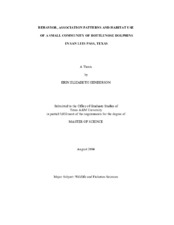Behavior, association patterns and habitat use of a small community of bottlenose dolphins in San Luis Pass, Texas
Abstract
Photoidentification surveys of bottlenose dolphins (Tursiops truncatus) were conducted from December of 2002 through December of 2003 in Chocolate Bay, Texas, and the adjacent Gulf of Mexico area. The research represented the continuation of an ongoing study of the dolphins of this area. Behavioral sampling was carried out on a small resident community of dolphins that seasonally reside in Chocolate Bay, as well as on dolphins found along the gulf coastline. Resident dolphins had a daily behavioral pattern, with peaks of foraging activity in the morning, traveling at midday, and socializing in late afternoon. Gulf dolphins had small mean group sizes of 3.4 and were primarily observed foraging and traveling, with little socializing. When resident and gulf dolphins interacted, the mean group size increased to 12 and the proportion of social behavior increased. Association indices demonstrated no long-lasting associations among adult male dolphins, while strong associations existed between several females. Females revealed two patterns of association; they were either members of a female band with other mother-calf pairs, or were solitary with no strong affiliations with any dolphins other than their calf. Males seemed to disperse upon maturation, which maintained the community size of approximately 35 animals. Behavioral evidence indicates the resident community is matrilinealy related and composed largely of adult females and their offspring. A few adult males remain resident, while most young males disperse from the community and may rove among the gulf population. Although mating probably occurs between resident and gulf dolphins, sources of both maternity and paternity for residents need to be determined, and further behavioral work needs to be carried out to support this hypothesis.
Citation
Henderson, Erin Elizabeth (2004). Behavior, association patterns and habitat use of a small community of bottlenose dolphins in San Luis Pass, Texas. Master's thesis, Texas A&M University. Texas A&M University. Available electronically from https : / /hdl .handle .net /1969 .1 /2807.


